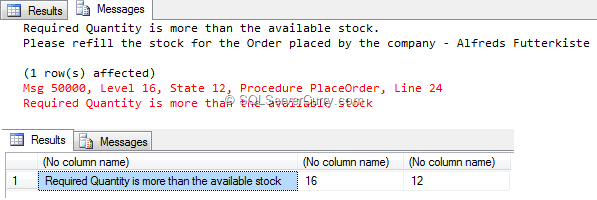Hypothetical Scenario - Customers in a Northwind database can place an order for a specific product or for multiple products. In case, the asking Order Quantity is more than the available stock for a specific product, a user defined exception should be raised and a notification sent to stock department to refill the stock for the required quantity for the order which needs to be processed.
To implement the above scenario, we will create a Stored Procedure, which will take the details of Customers using CustomerID, the Product using ProductID and required quantity. We will then check the available stock against the Quantity and accordingly we will throw the user defined exception, if the required quantity is more than the available quantity.
Earlier, we were using RAISERROR() function to throw the user defined error/exception in SQL Server. Let's see how we were using RAISERROR() statement to throw the error/exception.
For this demonstration, I am going to use Northwind database and the scenario is also build against the same database.
CREATE PROCEDURE PlaceOrder
(
@p_CustomerID VARCHAR(10),
@p_ProductID INT,
@p_RequiredQuantity INT
)
AS
BEGIN
DECLARE @v_ProductName VARCHAR(50)
DECLARE @v_UnitsInStack INT
DECLARE @v_CompanyName VARCHAR(20)
SELECT @v_ProductName=ProductName,@v_UnitsInStack=UnitsInStock FROM Products WHERE ProductID=@p_ProductID
SELECT @v_CompanyName=CompanyName FROM Customers WHERE CustomerID=@p_CustomerID
BEGIN TRY
IF(@p_RequiredQuantity>@v_UnitsInStack)
BEGIN
PRINT 'Required Quantity is more than the available stock. Please refill the stock for the Order placed by the company - ' + @v_CompanyName;
THROW 54600,'Required Quantity is more than the available stock.',12
END
END TRY
BEGIN CATCH
THROW
END CATCH
END
Now let's use the THROW statement to throw the user defined exception instead of RAISERROR() function.
CREATE PROCEDURE PlaceOrder
(
@p_CustomerID VARCHAR(10),
@p_ProductID INT,
@p_RequiredQuantity INT
)
AS
BEGIN
DECLARE @v_ProductName VARCHAR(50)
DECLARE @v_UnitsInStack INT
DECLARE @v_CompanyName VARCHAR(20)
SELECT @v_ProductName=ProductName,@v_UnitsInStack=UnitsInStock FROM Products WHERE ProductID=@p_ProductID
SELECT @v_CompanyName=CompanyName FROM Customers WHERE CustomerID=@p_CustomerID
BEGIN TRY
IF(@p_RequiredQuantity>@v_UnitsInStack)
BEGIN
PRINT 'Required Quantity is more than the available stock. Please refill the stock for the Order placed by the company - ' + @v_CompanyName;
THROW 54600,'Required Quantity is more than the available stock.',12
END
END TRY
BEGIN CATCH
THROW
END CATCH
END
In the above stored procedure, we are throwing a user defined exception using the new THROW statement in SQL Server 2012.
THROW uses the following parameters -
THROW Error_number, message, state

If you want the re-throw the exception, then in a catch block, you can use THROW without any parameters. This will throw the exception that was caught. Also make a note that the statement before the THROW must end with semicolon.
The output of the RAISERROR() function is as below -



2 comments:
IF exists(select zServiceTypeLookupId from [dbo].zServiceTypeLookup where ParentServiceId=@masterDataId)
BEGIN TRY
THROW 54600,'You can not DeActivate the record Which has Corresponding Child record(s).',12
END TRY
BEGIN CATCH
THROW --at the front-end side "ex.InnerException.Message" will give you the above error message
END CATCH
--simply i modified and used
Good example Shakti!
Post a Comment